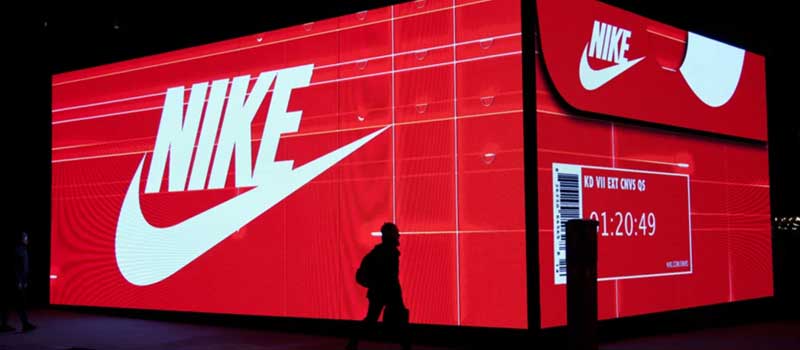How do you choose your brands?
Is it just because you like the product? The price? The cool jingle in the advert?
A lot of psychological processes go into our purchasing decisions.
We like to choose brands we trust and feel safe with.
We feel this through our experiences with brands which are shaped by the brand values.
Therefore, any brand strategy must clearly define brand values and use them as a guidepost for decisions and actions to build that trusting relationship.
What Are Brand Values?

Brand values are a set of guiding principles that dictate how the brand behaves.
Think of the brand values as a grounding compass that guides the brand story, actions, behaviors, and general decision-making process in the rest of the brand activity.
When you have clearly defined brand values, these explain what the company stands for.
That also means that when there are tough decisions to make for aspects of the business, revert to those brand values to stay true to the overarching principles.
What is the Role of Brand Values?

The role of brand values is to influence brand behavior.
Understand from the outset that brand values do not attract customers.
Do not think of them as a marketing tool in this way.
Instead, see them as foundational principles that shape the brand behavior which moulds the brand experience.
It’s the brand behavior and experience that attracts customers.
To put it another way, brands need to put their money where their mouth is.
Having a list of brand values won’t attract customers unless the brand lives and breathes the values through its behaviour.

Take Zappos as an example.
They don’t use their brand values as marketing, instead using them to guide brand behaviours which include:
Deliver WOW through service
Create fun and a little weirdness, and
Build open and honest relationships through communication.
In this way, brand behavior embodies the brand values, which attract customers.
PRO Brand Strategy BluePrint
Build Brands Like A Pro Brand Strategist

Brand Values vs Brand Mission vs Brand Vision

Often you may see these terms used synonymously, but there are key differences that it’s helpful to explain.
Brand mission = the ‘why’ of the company. The reason it exists and does what it does, as defined in the mission statement.
Brand vision = An aspirational look at the future of the company. Think of this as answering the classic “where will you be in five years” interview questions.
Brand values = The standards that guide branding activity and everything the business does toward its mission and vision.
Explore Brand Strategy
Programs & Tools
Why Are Brand Values Important?

Values are essential in defining brand behaviors, just as values are essential to how we act as humans.
Think about it.
Our values are passed to us by family members and those around us as we grow up. They shape how we behave and interact with other people.
Strong brand values are similarly influential.
The brand values reflect how the brand wants to be seen in the world in the eyes of consumers. They dictate how the brand behaves through every interaction and touchpoint with consumers.
It’s all about establishing a reputation through actions.
Brands that clearly define their core values stemming from the leadership, can integrate those values into everything the brand says and does from recruitment to onboarding to supply chains and everywhere in between.

Brands that live their values, indirectly communicate their values.
This approach is one element of a positioning strategy that helps define the brand’s place in the market.
In doing so, the brand can better connect to the audience through shared personal values.
Those strong core values lead to a clearly defined brand image that attracts loyal customers.
Let’s explore the benefits of brand values a bit further.
The Benefits of Brand Values

Defined brand values don’t just help with decision-making. Communicate brand values well, and they’ll also affect the business’s bottom line.
Here are a few advantages of instilling strong brand values.
Attracts Customers

I’ve already mentioned that customers like to buy from companies that share their values.
Brands that demonstrate values communicate values and attract audiences who are aligned with them.
Customers are also attracted by a good narrative.
Therefore, when you embed brand values into brand storytelling within broader marketing campaigns, you have a killer combination that resonates with the target audience and attracts new customers.
Improves The Brand Experience

With clearly established core brand values, helps to inform everything the company does.
This approach means that the customer experience with the brand is consistent across every interaction.
Audiences feel like they’re interacting with a business brand that always wears its heart on its sleeve without any jarring messages that conflict with the brand values.
This brand consistency can be a significant factor in encouraging a customer to make a purchase, helping the brand grow and retain market share.
Builds Brand Loyalty

Consistently displaying brand values and maintaining them over time will help build the perception that the brand is authentic and trustworthy.
Don’t underestimate consumers; they notice hypocrisy and conflicting messages.
By sticking to principles, you build a brand through customer loyalty, with buyers repeatedly returning to the brand.
Having loyal customers is critical to long-term business success.
Talent Retention

Increasingly, employees want to work for companies they can be proud of, with values that resemble theirs.
When values align, this often facilitates a strong brand culture.
This notion of shared values encourages employees to approach work more enthusiastically, supporting teamwork and increasing employee engagement.
According to Deloitte, 94% of executives and 88% of employees believe a distinct workplace culture is important to business success.
Highly engaged employees are great for business as the end consumers notice this tangible enthusiasm from employees encouraging brand loyalty and advocacy, resulting in a positive reinforcement loop that supports brand values.
Gains a Competitive Advantage

If a brand presents its brand values to foster deep connections with consumers, those consumers will choose that brand over its competitors.
By establishing that clear connection and relying on brand values to make quick decisions in a fast-paced competitive marketplace, brands can confidently rely, without getting complacent, on their relationship with customers.
With that reliable customer base, a brand can gain a competitive advantage.
Traits of Effective Brand Values

Brand values should be actionable.
It’s no use choosing an empty word for a brand value. Brands need to be able to act on their values in their actions.
Brand values should be memorable.
Staff and employees should be able to recall values easily to communicate those values to the marketplace through their actions. If they can’t keep them top-of-mind , then they’re not memorable enough.
Brand values should have a unique element.
This is where single keywords like sustainability or dependability won’t cut it.
If brands values sustainability and want to live by this as a core value, then “Do more to protect the planet” is far more personable and actionable than a keyword.
Brand values should be timeless.
Values aren’t something to chop and change regularly. They should stand the test of time and be as relevant in ten years as they were at the outset.
Examples of Successful Brand Values

Let’s see if we can spot some of these traits in some excellent examples of brand values.
Tesla

Tesla, almost inseparable from billionaire owner Elon Musk, is a leading car manufacturer at the forefront of the electric vehicle market.
Tesla’s core values are:
Doing the best
Taking risks
Respect
Constant learning, and
Environmental consciousness.
These values are backed up by a compelling mission statement: “To accelerate the world’s transition to sustainable energy”.
Straight off the bat, there are a few things to pick out here that clearly inform Tesla’s brand personality and company culture.
Tesla is happy to take risks, especially if they are taken specifically in the name of progress and innovation.
By embracing the risk-taker label, they hope to remain innovative as “drivers” of the world’s transition to sustainable energy.
Nike

Nike’s mission statement is “to bring inspiration and innovation to every athlete in the world.”
The asterisk marks the added, “If you have a body, you are an athlete.”
It backs this statement up with four “focus areas,” essentially the brand values.
These are:
Diversity, equity & inclusion
Repsonsible sourcing
Empowering communities
Protecting the planet
Through the mission statement and brand values, Nike elevates its status from a sports clothing manufacturer to a transformative force for good in the world.
Its focus on sustainability and diversity is backed up through sprawling ad campaigns promoting these causes.
These values resonate with the younger audience, who are increasingly aware of these issues and demand that their brands are forces for positive change.
The mission statement nicely ties in with the notion of inclusion.
The elaboration that an athlete means everybody makes a connection with the audience.
The majority of consumers are not professional athletes, yet they appreciate the idea that the brand sees them as such.
Patagonia

Patagonia’s mission statement is bold and striking: “We’re in business to save our home planet.”
This is an example of how a mission statement can initially seem entirely separate from the product or service the business owners are trying to sell.
It illustrates that mission statements and brand values are more often personality-based and reflect the principles of the brand more than the actual product or service.
Patagonia continues the theme in its core brand values:
Build the best product
Cause no unnecessary harm
Use business to protect nature
Not bound by convention
Patagonia taps into an environmentally conscious target market that won’t stand for less than the highest quality.
Its identity is closely tied to protecting nature. This value runs through everything that the company does, from its ad campaigns to web design to corporate social responsibility drives.
This consistency of messaging helps Patagonia stand out in relation to its competitors.
How to Define Core Brand Values

The brand values should be driven by the leadership team rather than the marketing or branding team.
That’s because the brand values should really come from the business owners as they put their personality into the business and drive it forward for the long term.
Let’s go through a five-step process for creating brand values.
#1. Discover Brand Values

I use the word discover because this first step is about discovering what’s important.
Business owners probably already know how they want to operate and have a good idea of the ‘how’ and ‘why’ of their business.
However, this first step is about communicating that.
Brainstorm ideas and try to define what is integral to the company’s identity.
At this point, this could be nothing more than single keywords or concepts that can be expanded on later.
#2. Define What The Customer Should Say About The Brand

What reputation should the brand have in the marketplace?
This step is about evaluating what you want the answers to be if consumers played word association with your brand.
And, to be clear, this isn’t referring to what consumers say about the products or services.
It’s about what consumers say about the personality and behavior of the brand.
Do you want consumers to view the brand as trustworthy and dependable or as a courageous, risk-taking innovator? Can a brand be both?
#3. Define Brand Experience

What do you want people to feel when interacting with the company?
What should the lasting impression be?
Remember. This extends beyond customers and includes everyone from suppliers to employees and everywhere in between.
This step is essential to defining the position the brand holds in the audience’s mind and in relation to its competitors.
How will your brand experience be unique to you, and how will can you instill your brand values into that experience? You’ll later codify much of the brand experience in a concrete document with your brand guidelines.
#4. Shortlist Keywords

There should be a pattern emerging as you progress through the process steps. As you explore these ideas, are there repeated instances of similar keywords or phrases?
That’s no accident!
That tells you that these are some of the keywords that are representative of the reputation you want to build in the market.
Keep these keywords top-of-mind as you build out the broader identity.
#5. Expand

As I mentioned earlier, single keywords aren’t enough because brand values need to have more substance and should be a more detailed set of guiding principles.
In other words, they need to be actionable enough to guide decisions and actions.
So, expand those keywords into unique sentences.
Write sentences from your core keywords that are representative of the brand you want to be.
Remember that your brand values will inform future decision-making and direction so that the brand is communicated consistently to consumers.
Over To You
Defining core brand values, and living by them, has never been more critical for brands.
Nowadays, consumers expect more from the brands they interact with.
They want more than a good product at a reasonable price.
They expect a personalized experience from a brand that goes about their business with an element of integrity.
As such, brands need to work harder to humanize themselves.
Brand values are at the core of this effort to humanize.
So define your brand values, make them actionable, integrate them into decision making processes of the business, and they’ll show up in the brand experience and the mind of the audience.
On-Demand Digital Program
Brand Master Secrets
Make the transition from hired-gun to highly valued brand strategist in less than 30 days. The systems, frameworks and tools inside this comprehensive program are all you need to level up.








